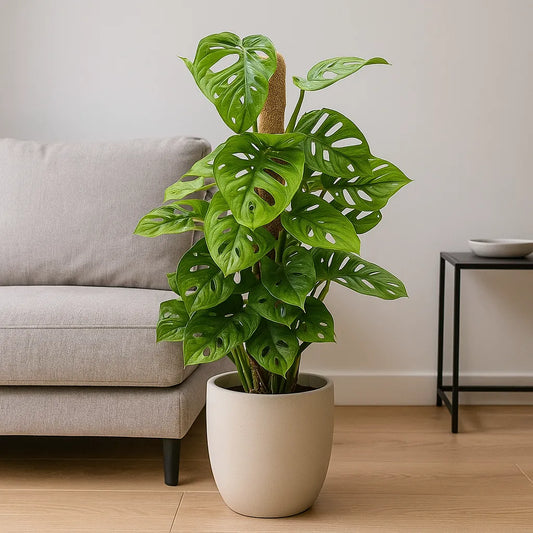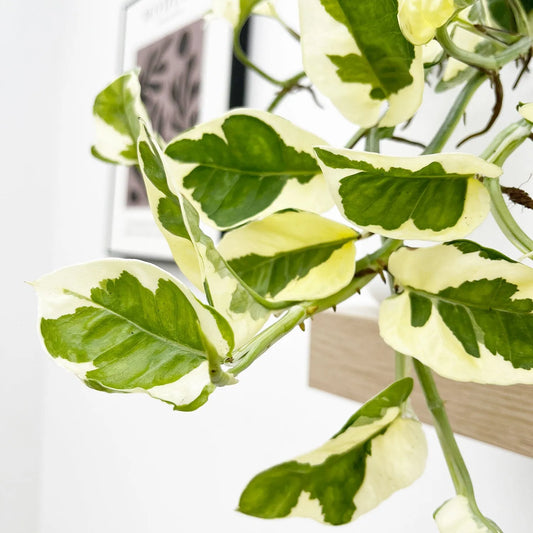A Guide to Calathea Soil
The Calathea is a rewarding tropical houseplant to grow, but it can sometimes be a bit fussy about its growing conditions. This picky nature can put some houseplant owners off owning Calathea plants, but you shouldn’t let yourself be put off.
Most of the problems you will encounter with Calathea can be sorted out by getting the right soil mix for your plant. In this guide we will take you through everything you need to know about Calathea soil.
What is the best soil for a Calathea?
The Calathea prefers a moist, but wet soil that allows water to drain easily whilst retaining just enough to keep the plant hydrated. You should choose a soil that includes Orchid bark or small bits of gravel which will help loosen the mixture, allowing the roots to develop quicker. The roots of the Calathea can be delicate so make sure you use a neutral soil as an acidic one can burn or kill the roots.
Signs you're using the wrong soil for Calathea
The soil you choose to use for your Calathea will affect your plant in many ways from water and nutrient absorption to stability and general health. Because the soil quality directly affects your plants health you will be able to quickly see when something is wrong. Make sure you are always checking for the following signs that your soil is wrong for your plant:
Soil is always wet - the speed that your Calathea absorbs water from the soil will change throughout the year, and you should always lessen how often you water during the winter. On average it should take your Calathea about a week to absorb all the moisture from a pot.
If you find that the soil is staying moist for much longer than this then it is likely that your soil is not well draining enough or that it is becoming too compact for the roots to spread out and absorb what it needs.
Soil has become dense - one of the best ways to tell if your plant needs watering is to insert your finger into the soil to test that the top few centimeters are dry. In an ideal soil you should be able to do this easily and with little resistance, but if you find it difficult or the soil feels like clay it is likely that the soil is far too dense and needs loosening up.
A dense soil can end up drowning or suffocating the roots of your Calathea. It can also make overwatering a lot easier which can lead to root rot and the death of the plant.
Curling and discolouration of the leaves - the Calathea is prized for its beautiful leaves and the wonderful, intricate patterns on these plants make a great ornamental feature, but they are also the Calatheas way of warning you that something is wrong.
Calathea leaves curling and turning yellow is a sign that the plant is waterlogged and that the roots are beginning to rot. When this happens your Calthea cannot absorb enough water or nutrients to sustain itself and it will begin to die.
Slow growing Calathea - on average your Calathea should grow about 5cm a month in the summer depending on the variety and growing conditions. You will soon grow accustomed to how fast your Calathea usually grows and when you notice that it has stopped or drastically slowed it may be a sign that something is wrong with your soil. This is usually a sign that your plant needs to be repotted and the soil completely replaced. Note that Calathea grow slower in winter so this may also be the cause.
Bad smelling soil - badly draining soil can lead to the organic materials in the mix to rot, giving off a bad smell that will be strong enough to fill the entire room. When the soil begins to smell it is a sign that your plant needs to be repotted immediately as it can lead to your plant dying quickly.
Once you have looked at your plant and discovered that something is wrong with your prayer plant it is time to start shopping for new soil. Most all-purpose potting soils from your local garden center will be good for your Calathea, but even then you should check each soil for the following.
How to choose the best Calathea soil
Aeration
A well aerated soil will allow air and water to circulate through it easily. This makes it a lot easier for the roots to absorb nutrients and moisture, making your Calathea healthier and faster growing. When looking for a well Aerated soil look for a mix that includes coarse materials such as bark, gravel or perlite which will break up the soil, creating pockets and channels for the air and water to travel through.
A badly aerated soil will trap carbon dioxide in it and stop the plant absorbing oxygen, causing slow growth
Well-draining
A well-draining soil allows water to easily pass through it and stop moisture pooling around the roots. When soil doesn’t drain properly, the build up of water in the soil makes them susceptible to diseases like root rot. This will eventually lead to the death of your plant. The best way to ensure that your soil is well-draining is to introduce organic materials like vermiculite, mulch or compost to the mix. You should also make sure that your pot has adequate drainage holes in the bottom to give any excess water somewhere to go.
Moisture retention
Whilst your soil needs to be well draining there is a balance to strike between how much water drains and how much is retained in the soil. Moisture in soil is used to hydrate and help feed your plant so it is important to strike the right balance. A soil with vermiculite, chipped bark or pine needles will retain more water and these materials will slowly release moisture back into the soil to allow a steady and constant supply of water to your Calatheas roots.
Ph level
Calathea plants don’t like acidic soil. Make sure you choose a soil with a Ph between 6.5 and 7. Anything more acidic will cause issues with the roots and bacteria in the soil which will eventually kill your plant.
When choosing a pre-mixed soil make sure you avoid any soils that are specifically designed for Roses and Azaleas. Most soils will also display the Ph level on the packaging. If you do accidentally choose a more acidic soil then you can lessen the Ph by adding finely ground limestone into the mix.
Nutrients
A good quality potting soil will have high levels of Nitrogen, Phosphorus and Potassium which are essential for making a Calathea thrive. All soil mixes will have this information on the packaging so you can easily compare different brands. However, if you choose a soil with lower levels of these nutrients in you can add more by introducing compost to the surface of the soil which will be broken down by bacteria into helpful nutrients. Another way to add these elements to your soil is to regularly feed with a fertiliser during watering.
Make your own Calathea soil
Sometimes it can be more effective to make your own Calathea soil mix. To do so you will need to be precise with your measurements and make sure you mix the soil well to incorporate all the ingredients to get a balanced soil. A favorite Cakathea soil mix used by plant experts is made up of the following
- 25% orchid bark
- 25% coconut coir
- 25% perlite
- 10% worm casing
- 5% activated charcoal
Our Calathea and Maranta potting mix provides the perfect mix for your Calathea plants so you don’t have to worry about mixing your own or whether it’s right for your plant.










